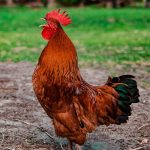 Although cock is the original English name for a male fowl, this sense of the word has been almost completely overtaken by rooster, a shift that occurred over the last three hundred years as cock came more and more to mean penis. First recorded in the ninth century, cock probably arose as an imitation of a rooster’s crowing, usually represented as cockadoodledoo (similarly, the French word for rooster—coq—reflects how the French represent the bird’s crowing: coquerico). In the early seventeenth century, cock came to be used as a ribald synonym for penis; this meaning of the word may have developed because a male fowl’s comb and wattle (the fleshy lobe hanging from his beak) engorge with blood as he struts, like the cock of the walk, through an admiring throng of hens. However, cock had also been used since the late fifteenth century to refer to the tap on a barrel of wine; this tap cock may be a completely different word from the rooster cock, or it may have been inspired by the fact that the handle on the tap was often shaped like a cock’s comb. In any event, this tap cock—essentially a tube used to discharge liquids—could easily have inspired the use of cock for penis. The upshot of these semantic developments was that cock ceased to be considered a polite word, especially in North America, even when it was used in a barnyard context; as a result, the word rooster emerged in the late eighteenth century to take up the semantic slack, rooster deriving safely from the bird’s tendency to roost. As a culinary term, cock continues to be used in the names of a few old dishes, including cock-a-leekie soup.
Although cock is the original English name for a male fowl, this sense of the word has been almost completely overtaken by rooster, a shift that occurred over the last three hundred years as cock came more and more to mean penis. First recorded in the ninth century, cock probably arose as an imitation of a rooster’s crowing, usually represented as cockadoodledoo (similarly, the French word for rooster—coq—reflects how the French represent the bird’s crowing: coquerico). In the early seventeenth century, cock came to be used as a ribald synonym for penis; this meaning of the word may have developed because a male fowl’s comb and wattle (the fleshy lobe hanging from his beak) engorge with blood as he struts, like the cock of the walk, through an admiring throng of hens. However, cock had also been used since the late fifteenth century to refer to the tap on a barrel of wine; this tap cock may be a completely different word from the rooster cock, or it may have been inspired by the fact that the handle on the tap was often shaped like a cock’s comb. In any event, this tap cock—essentially a tube used to discharge liquids—could easily have inspired the use of cock for penis. The upshot of these semantic developments was that cock ceased to be considered a polite word, especially in North America, even when it was used in a barnyard context; as a result, the word rooster emerged in the late eighteenth century to take up the semantic slack, rooster deriving safely from the bird’s tendency to roost. As a culinary term, cock continues to be used in the names of a few old dishes, including cock-a-leekie soup.
